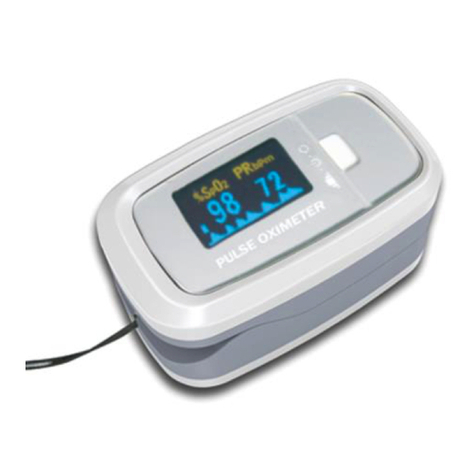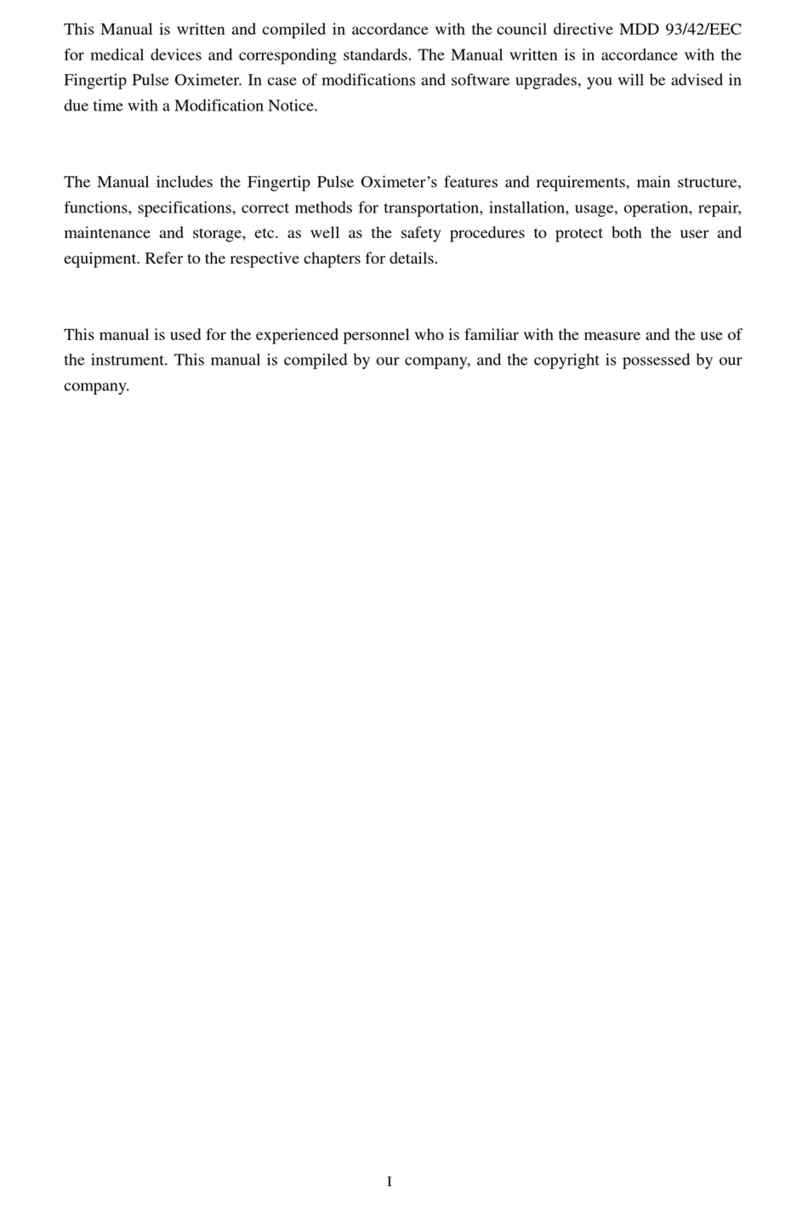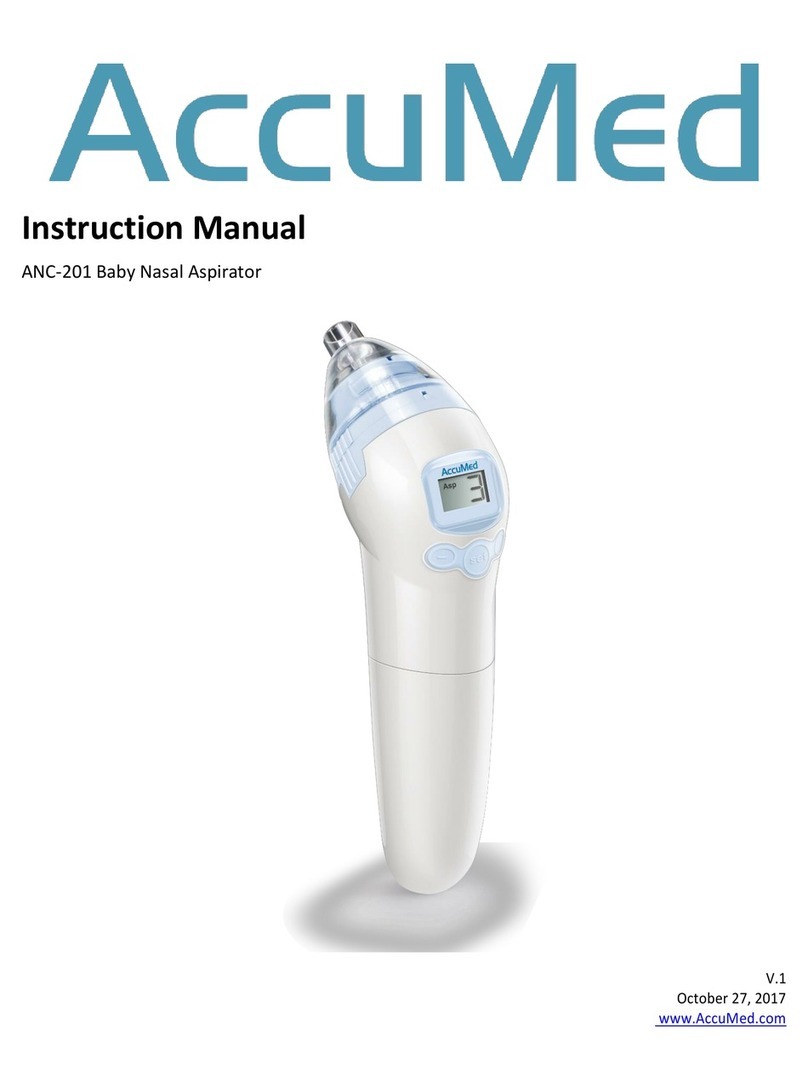User Manual
Instructions to User
Thank you very much for purchasing our product!
This Manual is written and compiled in accordance with the council directive MDD93/42/EEC for
medical devices and harmonized standards. The Manual is written for the current Pulse Oximeter. In
case of modifications and software upgrades, the information contained in this document is subject to
change without notice.
The Manual describes, in accordance with the Pulse Oximeter's features and requirements, main
structure, functions, specifications, correct methods for transportation, installation, usage, operation,
repair, maintenance, storage, etc. as well as the safety procedures to protect both the user and
equipment. Refer to the respective chapters for details.
Please read the Manual very carefully before using this equipment. These instructions describe the
operating procedures to be followed strictly; failure to follow these instructions can cause measuring
abnormalities, equipment damage and personal injury. The manufacturer is NOT responsible for the
safety, reliability, and performance issues and any monitoring abnormality, personal injury, and
equipment damage due to user's negligence of the operating instructions. The manufacturer's warranty
service does not cover such faults.
Due to the continual re-inovation, the specific products you received may not be totally in accordance
with the description of this User Manual. We would sincerely apologize for this.
This product is medical device, and can be used repeatedly. Its life span is 3 years.
WARNING:
An uncomfortable or painful feeling may develop if using the device ceaselessly, especially
for the microcirculation barrier patients. It is recommended that the sensor should not be
applied to the same finger for over 2 hours.
For the individual patients, there should be a more prudent inspecting in the placing
process. The device cannot be clipped on the edema and tender tissue.
The light (the infrared is invisible) emitted from the device is harmful to the eyes, so the user
and the maintenance man, cannot stare at the light.
Testee cannot use enamel or other makeup.
Testee’s fingernail cannot be too long.
Please peruse the relative content about the clinical restrictions and warnings.
This device is not intended for treatment.
The User Manual is published by our company. All rights reserved.
1 Safety
1.1 Instructions for Safe Operations
Check the main unit and all accessories periodically to make sure that there is no visible damage
that may affect patient’s safety and monitoring performance about the cables and transducers. It is
recommended that the device should be inspected once a week at least. When there is obvious
damage, stop using the monitor.
Necessary maintenance must be performed by qualified service engineers ONLY. Users are not
permitted to maintain it by themselves.
The oximeter cannot be used together with devices not specified in User's Manual. Only
accessories that are recommended by the manufacture can be used with this device.
This product is calibrated before leaving the factory.
1.2 Warnings
Explosive hazard—DO NOT use the oximeter in environments with flammable gas such as some
ignitable anesthetic agents.
DO NOT use the oximeter while the testee is undergoing a MRI and CT.
People who are allergic to rubber cannot use this device.
The disposal of scrap instruments, their accessories, and packing (including battery, plastic bags,
foam, and paper boxes) should follow the local laws and regulations.
Please check the packing before use to make sure the device and accessories are totally in
accordance with the packing list, or else the device may have the possibility of working abnormally.
Please don't measure this device with function test paper for the device's related information.
1.3 Attentions
Keep the oximeter away from dust, vibration, corrosive substances, explosive materials, high
temperatures, and moisture.
If the oximeter gets wet, please stop using it.
When it is carried from a cold environment to a warm or humid environment, please do not use it
immediately.
DO NOT operate keys on front panel with sharp materials.
High temperature or high pressure steam disinfection of the oximeter is not permitted. Refer to
User Manual in the relative chapter for instructions on cleaning and disinfection.
Do not have the oximeter immerged in liquid. When it needs cleaning, please wipe its surface with
medical alcohol on soft material. Do not spray any liquid on the device directly.
When cleaning the device with water, the temperature should be lower than 60ºC.
As to the fingers which are too thin or too cold, it would probably affect the normal measure of the
patients' SpO2and pulse rate. Please clip a thick finger such as thumb and middle finger deeply
enough into the probe.
Do not use the device on infants or neonatal patients.
The product is suitable for children above four years old and adults (weight should be between
15kg to 110kg).
The device may not work for all patients. If you are unable to achieve stable readings, discontinue
use.
The update period of data is less than 5 seconds, which is changeable according to different
individual pulse rate.
The waveform is normalized. Please read the measured value when the waveform on screen is
equably and steady-going. This measured value is optimal value and the waveform at the moment
is the standard one.
If some abnormal conditions appear on the screen during the test process, pull out the finger and
reinsert to restore normal use.
The device has a normal life span of three years since the first electrified use.
The hanging rope attached the product is made from non- allergy material. If particular groups are
sensitive to the hanging rope, stop using it. In addition, pay attention to the use of the hanging rope.
Do not wear it around the neck to avoiding cause harm to the patient.
The instrument does not have a low-voltage alarm function. It only shows the low-voltage. Please
change the battery when the battery energy is used up.
When the parameter is specific, the instrument does not have an alarm function. Do not use the
device in situations where alarms are required.
Batteries must be removed if the device is going to be stored for more than one month, or else
batteries may leak.
A flexible circuit connects the two parts of the device. Do not twist or pull on the connection.
2 Overview
The pulse oxygen saturation is the percentage of HbO2in the total Hb in the blood, so-called the O2
concentration in the blood. It is an important bio-parameter for the respiration. For the purpose of
measuring the SpO2more easily and accurately, our company developed the Pulse Oximeter. At the
same time, the device can measure the pulse rate.
The Pulse Oximeter features small size, low power consumption, convenient operation, and portability.
It is only necessary for patients to put one of their fingers into a fingertip photoelectric sensor for
diagnosis, and a display screen will directly show the measured value of Hemoglobin Saturation.
2.1 Classification:
Class II b, (MDD93/42/EEC IX Rule 10)
2.2 Features
Operation of the product is simple and convenient.
The product is small in size, light in weight (total weight is about 50g including batteries) and
convenient to carry.
Power consumption of the product is low and the two originally equipped AAA batteries can be
operated continuously for 20 hours.
The product will automatically be powered off when no signal is detected by the product within 5
seconds.
2.3 Major Applications and Scope of Application
The Pulse Oximeter can be used to measure human Hemoglobin Saturation and pulse rate through the
finger, and indicate the pulse intensity by the bar-display. The product is suitable for use in family,
hospital (ordinary sickroom), Oxygen Bar, social medical organizations, and also the measure of oxygen
saturation and pulse rate.
The product is not suitable for use in continuous supervision for patients.
The problem of overrating would emerge when the patient is suffering from toxicosis which
is caused by carbon monoxide. The device is not recommended to be used under this
circumstance.
2.4 Environment Requirements
Storage Environment
a) Temperature: -40ºC~+60Cº
b) Relative humidity: ≤95%
c) Atmospheric pressure: 500hPa~1060hPa
Operating Environment
a) Temperature: 10ºC~40ºC
b) Relative Humidity: ≤75%
c) Atmospheric pressure: 700hPa~1060hPa
3 Principle and Caution
3.1 Principle of Measurement
Principle of the Oximeter is as follows: An experience formula of data processing is established taking
use of Lambert Beer Law according to Spectrum Absorption Characteristics of Reductive Hemoglobin
(Hb) and Oxyhemoglobin (HbO2) in glow & near-infrared zones. Operation principle of the instrument is:
Photoelectric Oxyhemoglobin Inspection Technology is adopted in accordance with Capacity Pulse
Scanning & Recording Technology, so that two beams of different wavelength of lights can be focused
onto the human nail tip through a perspective clamp finger-type sensor. Then a measured signal can be
obtained by a photosensitive element, information acquired through this will be shown on screen
through processing in electronic circuits and a microprocessor.
Figure 1 Operating principle
3.2 Caution
1. The finger should be placed properly in the device (see the attached illustration of this
manual ,Figure 5), or else it may cause inaccurate measurement.
2. The SpO2sensor and photoelectric receiving tube should be arranged in a way with the subject’s
arteriole in a position there between.
3. The SpO2sensor should not be used at a location or limb tied with arterial canal or blood pressure
cuff or receiving intravenous injection.
4. Make sure the optical path is free from any optical obstacles like rubberized fabric.
5. Excessive ambient lightmay affect the measuring result. It includes fluorescent lamp, dual ruby light,
infrared heater, direct sunlight, etc.
6. Strenuous action of the subject or extreme electrosurgical interference may also affect the accuracy.
7. Testee cannot use enamel or other makeup.
3.3 Clinical Restrictions
1. As the measurement is taken on the basis of arteriole pulse, substantial pulsating blood flow of the
subject is required. For a subject with weak pulse due to shock, low ambient/body temperature,
major bleeding, or use of vascular contracting drug, the SpO2waveform (PLETH) will decrease. In
this case, the measurement will be more sensitive to interference.
2. For those with a substantial amount of staining dilution drug (such as methylene blue, indigo green,
and acid indigo blue), carbon monoxide hemoglobin (COHb), methionine (Me+Hb), or thiosalicylic
hemoglobin, and some with icterus problem, the SpO2determination by this monitor may be
inaccurate.
3. The drugs like dopamine, procaine, prilocaine, lidocaine, and butacaine may also be a major factor
blamed for serious error of SpO2measurement.
4. As the SpO2value serves as a reference value for judgment of anemic anoxia and toxic anoxia,
some patients with serious anemia may also report good SpO2measurement.






















